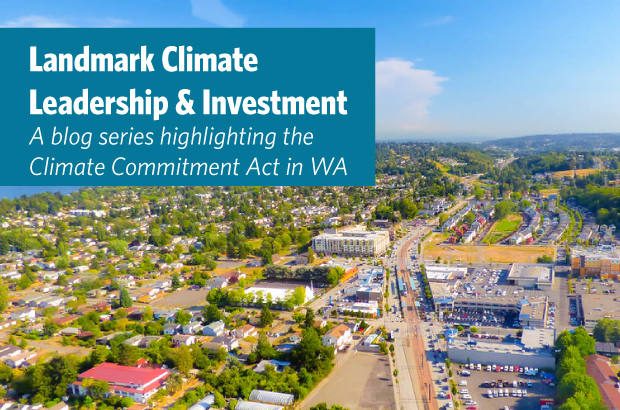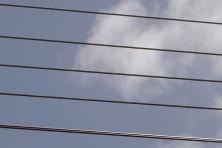Part 2: Centering Environmental Justice in the Climate Commitment Act
Next week, Washington will hold its first Climate Commitment Act (CCA) auction, making it the second state in the nation to implement a cap-and-invest program. This state auction will set in motion the biggest investment in clean energy, air quality improvements, and community-based solutions our state has ever seen. With a lot of buzz surrounding the CCA ahead of the auction, we’ve created this blog series to provide you with the law’s fundamentals. We started this series off with a “cap-and-invest 101” primer that you can read here. In this post, we’ll highlight some groundbreaking pieces unique to Washington’s law: environmental justice provisions that prioritize air pollution reductions in overburdened communities, ongoing oversight by an Environmental Justice Council, and significant investments in communities most impacted by poor air quality, economic barriers, and climate impacts.
Learning from California
In 2013, California became the first state to enact a cap-and-invest program in the country. As the program got off the ground, environmental justice advocates in California criticized it for doing little to improve air quality conditions in communities. Many of the US’ most polluting industries are located within low-income, Black, and/or Indigenous communities as well as other communities of color due to decades of racist housing practices such as redlining, so reducing statewide climate emissions must be paired with efforts to reduce the local air pollutants that often come with these industries. Washington lawmakers listened to these critiques and designed the policy to ensure environmental justice and air quality improvements were at the forefront of the program.
A new program focused on local air pollution
While the CCA includes numerous environmental justice provisions, the new, expansive air quality monitoring program is the most central. The program will regulate criteria pollutants from all sources of emissions—not just emissions covered under the greenhouse gas cap—such as particulate matter, ozone, and nitrogen oxide. These pollutants are often concentrated in industrial and transportation corridors near low-income and BIPOC neighborhoods, and have negative and compounding health impacts.
The Department of Ecology and local clean air agencies will work together to:
-
Identify overburdened communities. Ecology will rely on the best available data and input from stakeholders and Tribes on the different air quality impacts they face from a variety of sources to identify overburdened communities.
-
Expand air quality monitoring. Ecology must fill gaps in its existing air quality monitoring network to ensure a lack of data does not act as a barrier to identifying and improving poor air quality.
-
Identify sources of criteria pollutants. Using its existing and new air quality monitoring data, Ecology will produce a biennial report summarizing the greatest sources of criteria pollutants impacting different communities across the state.
-
Work with local clean air agencies to adopt air quality targets and enforce stricter air quality standards. The program requires Ecology to issue an enforceable order requiring pollution reductions to facilities that don’t meet these standards.
-
Develop community engagement plans. Building on the requirements of the Healthy Environment for All Act, Ecology must develop a plan to engage with overburdened communities and vulnerable populations throughout this process.
The role of the Environmental Justice Council
Washington’s Environmental Justice Council (EJ Council) has a critical role in developing and implementing the CCA. The EJ Council will recommend how to best invest CCA funds in communities, support the creation of community engagement plans, and analyze the overall benefits or impacts of the program on overburdened communities. As lawmakers and Ecology all work to implement the different pieces of the bill, it is imperative that they thoroughly review and integrate EJ Council recommendations. We encourage you to read more about the Environmental Justice Council and their critical body of work here.
Tribal engagement, consultation, and investment as key indicators of measuring the CCA’s success
Tribes played a leading role in the passage of the CCA and their consultation and guidance on implementation is essential. The Washington Legislature passed a law in 2022 to create a Tribal Consultation Grant Program to provide resources to Tribes dealing with a massive influx in requests for consultation. These grants are a critical starting point for enabling meaningful government-to-government engagement, but Ecology must also provide enough time and information considering Tribes’ own timelines and review capacity throughout the lifetime of the CCA and its cap-and-invest program.
Notably, the Legislature also dedicated $50 million from CCA funds per biennium towards helping Tribes adapt to the impacts of climate change, such as the growing threat of sea-level rise, the increasing frequency and ferocity of wildfire seasons on their land, and more.
Offsets as additional benefits for conservation – not as a proxy for emissions reductions
Washington lawmakers were also responsive to criticisms of offsets in California’s law when writing the CCA. Put simply, offsets are land conservation, preservation, and enhancement projects that naturally sequester and store carbon (such as forest restoration or wetland enhancement), but are often located away from communities impacted by pollution. Under the CCA, an increasing majority of offsets must directly benefit Washington. Most critically, Washington’s program treats emissions covered by an offset as emissions under the cap, rather than emissions reductions. When a covered entity in Washington purchases an offset, an equal amount of allowances is retired from the allowance pool. This structure not only maintains the efficacy of the cap, but also makes offsets a purely additional benefit for land conservation in the state. California’s program does neither of these things—offsets are treated as emissions reductions and offset purchases do not affect the cap or allowance availability—effectively slowing down the state’s emissions reductions and enabling businesses to keep polluting in overburdened communities for longer.
Offsets in Washington also act as a funding source for Tribes. The CCA dedicates $5 million towards a Tribal offset grant program to support interested Tribes in launching offset projects, which will ultimately bring significant investments to acres and acres of Tribal lands.
California’s ongoing investments highlight the example of an enormous opportunity for WA’s CCA to fund climate action and energy justice
One of the clearest successes of California’s cap-and-invest program was the ability to invest in communities across the state with this new source of funding. California has now invested billions of dollars in programs such as:
-
Clean truck and bus voucher program to incentivize the transition to zero-emission heavy-duty vehicles – a leading source of diesel pollution in overburdened communities.
-
Community Air Grants to support California’s community-based organizations and Tribes in building community capacity and partnering with the state to identify, evaluate, and reduce air pollution in their communities.
-
Energy efficiency incentives for low-income, multi-family homes to improve indoor air quality and reduce energy burdens for low-income households.
-
Countless other programs that enhance natural climate solutions such as wetlands and coastlines, bolster clean energy deployment in the state, and more.
Right now in Washington, the Legislature is actively working to allocate almost $2 billion of CCA investments. To ensure that these investments reach communities most impacted by climate pollution, at least 35% (and a goal of 40%) of these funds must directly benefit overburdened communities, while a minimum of 10% must directly benefit Tribes.
In our next and final blog of the series, we’ll highlight the investments that have the biggest promise to reduce climate pollution, clean up our air, get toxic gas out of our homes and buildings, and build more resilient communities. You can read more about the Invest in Climate Action Priority here and here and also on the Environmental Priorities Coalition webpage.





